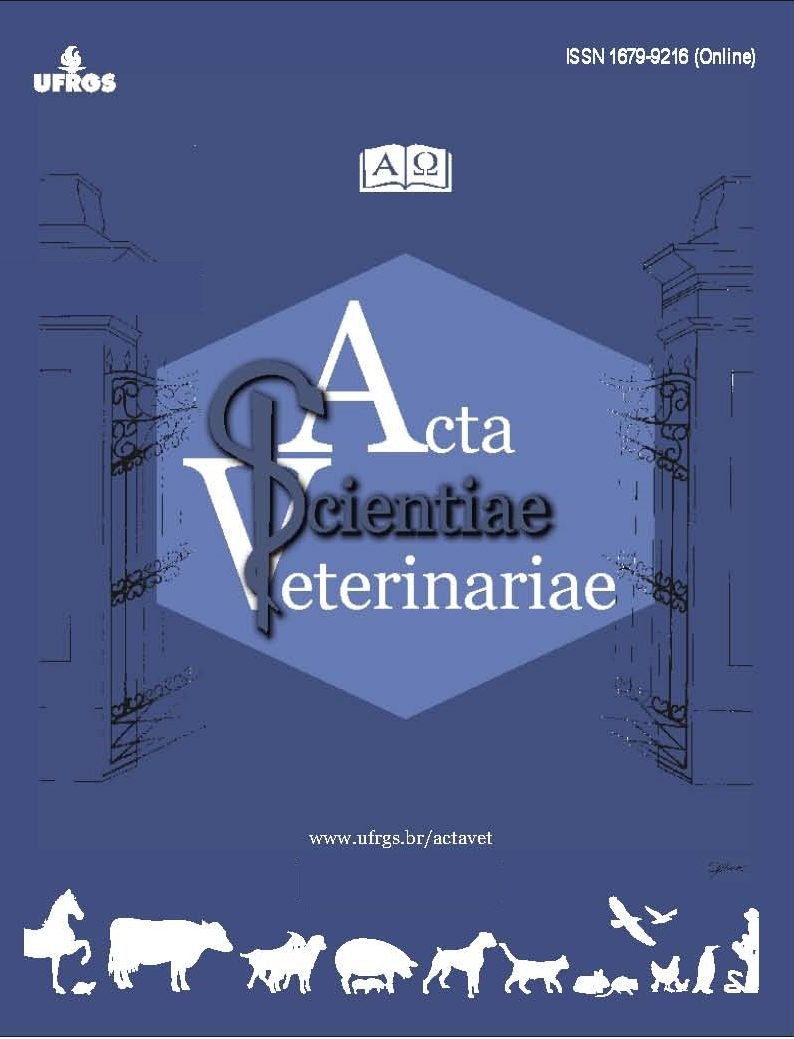Complicação cirúrgica e re-intervenção em cão com subluxação atlantoaxial tratada por estabilização cirúrgica ventral
DOI:
https://doi.org/10.22456/1679-9216.137936Palavras-chave:
canino, Instabilidade Atlantoaxial, neurocirurgia, neurologia, malformações cervicaisResumo
Background: The atlantoaxial subluxation condition presents neurological alterations due to joint instability, vertebral misalignment, and subsequent compression and injury to the spinal cord parenchyma. It occurs more frequently in young dogs of toy breeds, but it can also happen in large breed dogs and cats. The present study aims to report a case of atlantoaxial instability in a canine, a 7-year-old female Yorkshire Terrier, through surgical treatment using a modified ventral (parasagittal) approach.
Case: A 7-year-old, 4.5 kg female Yorkshire Terrier, spayed, was brought to OrthoSupport Pet with a complaint of vocalization suggestive of pain when jumping off the sofa. During the clinical/neurological examination, the animal exhibited signs consistent with a cervical syndrome. The diagnosis was made through a computed tomography scan, which revealed dorsal displacement of the axis in relation to the atlas. As a result, surgical treatment was initiated using the modified ventral stabilization technique (parasagittal) with screws and polymethylmethacrylate. However, the patient experienced a recurrence of the neurological symptoms seven days after the surgical procedure, attributed to implant failure. A second surgical intervention was performed, resulting in therapeutic success.
Discussion: The patient exhibited non-ambulatory tetraparesis after jumping off the sofa. The animal's caregiver reported that similar episodes had occurred in the past during the pet's life. It's worth noting that although most animals display clinical signs before the age of 6 months, older patients can also develop atlantoaxial subluxation due to joint instability, as described in this case report. Animals affected by atlantoaxial subluxation can manifest a range of symptoms, from cervical pain to tetraplegia, and, in severe cases, even respiratory failure leading to death. The presentation of signs after a jump, coupled with the subsequent improvement in clinical signs, suggests a distinctive feature where there is intermittent misalignment and realignment of the atlantoaxial joint, resulting in intermittent spinal cord compression. The parasagittal approach is a modification of the ventral approach that requires less dissection, reduces tissue recovery time, involves less manipulation, and minimizes the displacement of structures like the trachea. Initially, ventral stabilization with screws and polymethylmethacrylate was performed as per the routine, but the implant failed. Subsequently, a second intervention was conducted, involving the addition of transarticular pins and a screw at C3, resulting in a successful therapeutic outcome. The parasagittal approach offers advantages as an alternative to the conventional ventral approach. Although the presentation of the disease in animals over two years of age is relatively uncommon, it should still be considered as a differential diagnosis when the clinical signs are compatible.
Downloads
Referências
Bray K.Y., Platt S.R., Kent M., Olby N.J., Early P.J., Mariani C.L., Muñana K.R. & Holmes S.P. 2023. Magnetic resonance imaging characteristics of atlanto-axial subluxation in 42 dogs: Analysis of joint cavity size, subluxation distance, and craniocervical junction anomalies. Open Veterinary Journal. 13(9): 1091-1098. DOI: 10.5455/OVJ.2023.v13.i9.4. DOI: https://doi.org/10.5455/OVJ.2023.v13.i9.4
Dewey C.W. & Fossum T.W. 2021. Cirurgia da coluna cervical. In: Fossum T.W. (Ed). Cirurgia de Pequenos Animais.
ed. Rio de Janeiro: GEN Guanabara Koogan, pp.1365-1387.
Dickomeit M., Alves L., Pekarkova M., Gorgas D. & Forterre F. 2011. Use of a 1.5 mm butterfly locking plate for stabilization of atlantoaxial pathology in three toy breed dogs. Veterinary and Comparative Orthopaedics and Traumatology. 24(3): 246-251. DOI: 10.3415/VCOT-10-07-0114. DOI: https://doi.org/10.3415/VCOT-10-07-0114
Ozak A., Besalti O., Pekcan Z. & Eminaga S. 2006. Ventral fixation in atlantoaxial instability with axial fracture in DOI: https://doi.org/10.1055/s-0038-1632974
a dog. Veterinary and Comparative Orthopaedics and Traumatology. 19(1): 57-59. PMID: 16594545.
Platt S.R. & Chambers J.N. & Cross A. 2004. A modified ventral fixation for surgical management of atlantoaxial
subluxation in 19 dogs. Veterinary Surgery. 33(4): 349-354. DOI: 10.1111/j.1532-950X.2004.04050.x. DOI: https://doi.org/10.1111/j.1532-950X.2004.04050.x
Schneider M., Waschk M., Precht M. C., Nathues C., Moissonnier P., Aikawa T., Schnötzinger D., Schmidt M., Garosi D. & Forterre F. 2017. Incidence of abnormalities of the second and third cervical vertebral junction in dogs with atlantoaxial instability: a multicentre study. Veterinary and Comparative Orthopaedics and Traumatology. 30(6):
-429. DOI: 10.3415/VCOT-17-01-0004. DOI: https://doi.org/10.3415/VCOT-17-01-0004
Shores A. & Tepper L.C. 2007. A modified ventral approach to the atlantoaxial junction in the dog. Veterinary Surgery.
(8): 765-770. DOI: 10.1111/j.1532-950X.2007.00334.x. DOI: https://doi.org/10.1111/j.1532-950X.2007.00334.x
Slanina M.C. 2016. Atlantoaxial instability. Veterinary Clinics of North America: Small Animal Practice. 46(2): 265-
DOI: 10.1016/j.cvsm.2015.10.005. DOI: https://doi.org/10.1016/j.cvsm.2015.10.005
Sorjonen D.C. & Shires P.K. 1981. Atlantoaxial instability: a ventral surgical technique for decompression, fixation,
and fusion. Veterinary Surgery. 10(1): 22-29. DOI:10.1111/j.1532-950X.1981.tb00625.x. DOI: https://doi.org/10.1111/j.1532-950X.1981.tb00625.x
Stalin C., Gutierrez-Quintana R., Faller K., Guevar J., Yeamans C. & Penderis J. 2015. A review of canine atlantoaxial joint subluxation. Veterinary and Comparative Orthopaedics and Traumatology. 28(1): 1-8. DOI: 10.3415/VCOT-14-05-0064 DOI: https://doi.org/10.3415/VCOT-14-05-0064
Arquivos adicionais
Publicado
Como Citar
Edição
Seção
Licença
Copyright (c) 2024 Adan Cabreira, Murilo Henrique Dias da Silva, Thales Bregalioli, Gabriel Antonio Covino Diamante

Este trabalho está licenciado sob uma licença Creative Commons Attribution 4.0 International License.
This journal provides open access to all of its content on the principle that making research freely available to the public supports a greater global exchange of knowledge. Such access is associated with increased readership and increased citation of an author's work. For more information on this approach, see the Public Knowledge Project and Directory of Open Access Journals.
We define open access journals as journals that use a funding model that does not charge readers or their institutions for access. From the BOAI definition of "open access" we take the right of users to "read, download, copy, distribute, print, search, or link to the full texts of these articles" as mandatory for a journal to be included in the directory.
La Red y Portal Iberoamericano de Revistas Científicas de Veterinaria de Libre Acceso reúne a las principales publicaciones científicas editadas en España, Portugal, Latino América y otros países del ámbito latino





